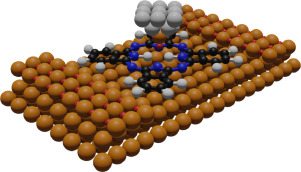当前位置:
X-MOL 学术
›
Surf. Sci.
›
论文详情
Our official English website, www.x-mol.net, welcomes your
feedback! (Note: you will need to create a separate account there.)
H2Pc and Pentacene on Cu(110)-(2×1)O: A combined STM and nc-AFM study
Surface Science ( IF 2.1 ) Pub Date : 2020-06-01 , DOI: 10.1016/j.susc.2020.121590 Angel Garlant , Bret Maughan , Percy Zahl , Oliver L.A. Monti
Surface Science ( IF 2.1 ) Pub Date : 2020-06-01 , DOI: 10.1016/j.susc.2020.121590 Angel Garlant , Bret Maughan , Percy Zahl , Oliver L.A. Monti

|
Abstract Scanning tunneling microscopy (STM) and non-contact atomic force microscopy (nc-AFM) with a CuO tip is used to investigate adsorption of metal-free phthalocyanine (H2Pc) and pentacene on the Cu(110)-(2×1)O striped-phase reconstructed surface. We show that the combination of STM and nc-AFM is necessary to reveal the detailed adsorption geometry, necessary for interpreting the observed STM contrast. Comparison of the nc-AFM images with simulations shows that some of the H2Pc molecules are deformed out-of-plane on this surface, while pentacene retains its molecular geometry regardless of adsorption site. Our work highlights how the stiffness of CuO tips makes it possible to probe the structure of organic semiconductor / metal interfaces.
中文翻译:

H2Pc 和并五苯在 Cu(110)-(2×1)O 上:结合 STM 和 nc-AFM 研究
摘要 具有 CuO 尖端的扫描隧道显微镜 (STM) 和非接触式原子力显微镜 (nc-AFM) 用于研究无金属酞菁 (H2Pc) 和并五苯在 Cu(110)-(2×1) 上的吸附O 条纹相重建表面。我们表明,STM 和 nc-AFM 的组合对于揭示详细的吸附几何结构是必要的,这对于解释观察到的 STM 对比度是必要的。nc-AFM 图像与模拟的比较表明,一些 H2Pc 分子在该表面上发生平面外变形,而并五苯保留其分子几何形状,而不管吸附位点如何。我们的工作突出了 CuO 尖端的刚度如何使探测有机半导体/金属界面的结构成为可能。
更新日期:2020-06-01
中文翻译:

H2Pc 和并五苯在 Cu(110)-(2×1)O 上:结合 STM 和 nc-AFM 研究
摘要 具有 CuO 尖端的扫描隧道显微镜 (STM) 和非接触式原子力显微镜 (nc-AFM) 用于研究无金属酞菁 (H2Pc) 和并五苯在 Cu(110)-(2×1) 上的吸附O 条纹相重建表面。我们表明,STM 和 nc-AFM 的组合对于揭示详细的吸附几何结构是必要的,这对于解释观察到的 STM 对比度是必要的。nc-AFM 图像与模拟的比较表明,一些 H2Pc 分子在该表面上发生平面外变形,而并五苯保留其分子几何形状,而不管吸附位点如何。我们的工作突出了 CuO 尖端的刚度如何使探测有机半导体/金属界面的结构成为可能。











































 京公网安备 11010802027423号
京公网安备 11010802027423号